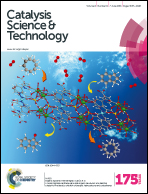An in situ approach to preparing Ni2P/SiO2 catalyst under mild conditions and its performance for the deoxygenation of methyl laurate to hydrocarbons†
Abstract
Ni2P/SiO2 was in situ prepared from Ni/SiO2via a phosphorization process using a dodecane solution containing triphenylphosphine (TPP) as the phosphorus source on a fixed-bed reactor. The influence of the phosphorization condition (nominal P/Ni molar ratio, temperature, WHSV of TPP and atmosphere) on the structure of the phosphorized samples was investigated. The sample structure was characterized by means of XRD, TEM, ICP-AES, TGA, N2 sorption, and FT-IR and magnetic property. It was found that the phosphorization of metallic Ni to Ni2P was promoted by increasing the phosphorization temperature and nominal P/Ni molar ratio and decreasing the WHSV of TPP. The phosphorization rate was much faster in the H2 atmosphere than the N2 one, ascribed to the formation of reactive H atoms on the Ni atoms that facilitated the cleavage of the P–C bond in PPT releasing more reactive PH3/P. To prepare the well-crystallized Ni2P/SiO2 in the H2 atmosphere, the minimum temperature (250 °C) and nominal P/Ni ratio (0.67) were necessary. Also, the Ni2P crystallite size in Ni2P/SiO2 was determined by the Ni one in Ni/SiO2, and no sintering took place during the phosphorization even at 400 °C. It is worth stating that there was a carbonaceous deposit formed on the in situ prepared catalysts, which was harmful for the catalyst activity for the deoxygenation of methyl laurate to hydrocarbons. The phosphorization condition greatly affected the performance of the resulting catalysts. On the whole, the Ni2P/SiO2 catalyst with good performance was prepared under a suitable phosphorization condition (i.e., 300 °C, nominal P/Ni ratio of 0.75, TPP WHSV of 0.5 h−1, and H2 atmosphere). Under the reaction conditions of 340 °C, 3.0 MPa, methyl laurate WHSV of 5 h−1 and H2/methyl laurate molar ratio of 25, it gave the conversion of methyl laurate and the total selectivity for C11 and C12 hydrocarbons higher than 98% and 96% during 100 h, respectively, exhibiting good stability. Finally, we propose a mechanism for the phosphorization of Ni/SiO2.


 Please wait while we load your content...
Please wait while we load your content...